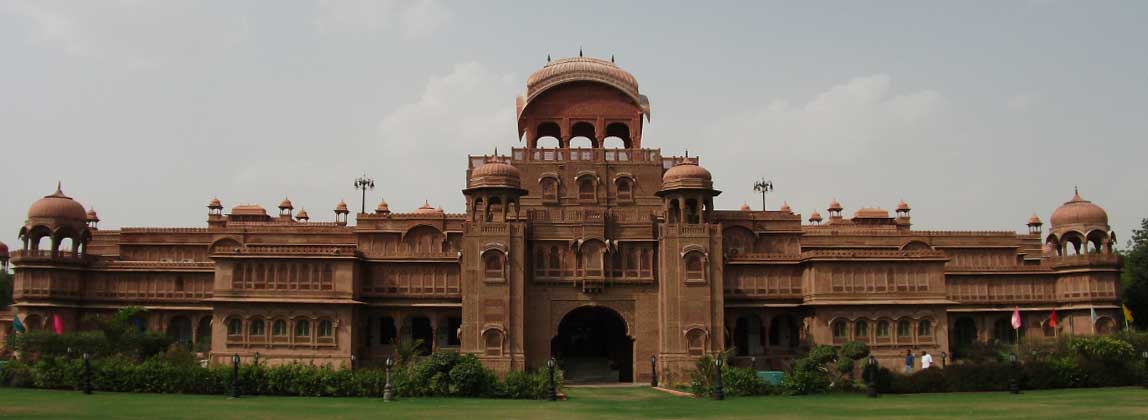


BIKANER- The city gets its name from Rao Bika, a Rajput of the Rathor clan, who founded it in 1488 AD. From its small origins, today it has developed into the fourth largest city in Rajasthan. If ever beauty has bloomed in a desert, it has been at Bikaner. The imposing palaces, beautiful and richly sculptured temples of red and yellow sand stones display some of the finest creations of Rajput civilization. Bikaner retains the medieval grandeur that permeates the city's lifestyle. More readily called the camel country, the city is distinguished for the best riding camels in the world.
Bhandeswar Jain Temple is a fifteenth century temple and is the oldest monument of Bikaner. The temple is decorated with rich mirror work, frescoes and gold leaf paintings.
It is a farm engaged in research on camels. It is located about 8 km from Bikaner. This is one of its kind institutes in India. The farm is complex of cables stables and enclosures and buildings. One can enjoy camel ride or ice cream made of camel milk. The farm permits tourists at certain hours of the day. It is interesting to watch camel calves gamboling around and also camels returning from a day out in the desert. It is also known as Camel Breeding Farm and was established in 1984 by the central government.
Deshnok is a small village situated 32 kms south of Bikaner city along the Jodhpur Road. It is a pilgrim centre of Karni Mata – said to be an incarnation of Goddess Durga-who lived here in the 14th century and performed many miracles. The temple here is famous for the approximately 20,000 Black Rats that live, and are revered in, the temple. Out of all of the thousands of rats in the temple, there are a few white rats, which are considered to be especially holy. Sighting them is a special blessing and visitors put in extensive efforts to bring them forth, offering prasad, a sweet holy food.
Deshnok is a small village situated 32 kms south of Bikaner city along the Jodhpur Road. It is a pilgrim centre of Karni Mata – said to be an incarnation of Goddess Durga-who lived here in the 14th century and performed many miracles. The temple here is famous for the approximately 20,000 Black Rats that live, and are revered in, the temple. Out of all of the thousands of rats in the temple, there are a few white rats, which are considered to be especially holy. Sighting them is a special blessing and visitors put in extensive efforts to bring them forth, offering prasad, a sweet holy food.
Initially the museum was established in a red sandstone building near the Lallgarh Palace by Maharaja Ganga Singhji to celebrate his golden jubilee reign in Bikaner. Later Maharaja Karni Singhji constructed a larger building and the Ganga Golden Jubilee Museum was shifted to it in the year 1954. The collection includes 71 stone sculptures, 10 inscriptions, 192 miniature paintings, 124 terracotta's, 27 metallic objects, 574 arms, 22241 coins and 1108 objects of local art, craft and textiles.
It is an unassailable fortress, which has never been conquered. Built in 1593 A.D. by Raja Rai Singh, one of the most distinguished generals in the army of Emperor Akbar, the fort is a formidable structure encircled by a moat. It is one of the few major forts in Rajasthan which is not built on a hilltop. The modern city of Bikaner has developed around the fort. The main entrance to the fort is Karan Pol [gate] that is east facing. Next to it is the Suraj Pol meaning the Sun gate. The fort situates in it some very magnificent palaces like Anup Mahal, Ganga Niwas and Rang Mahal or palace of pleasure.
It's a museum located in the great Junagarh Fort. The museum is dedicated to royal costumes, textiles and accessories. 'Poshaks' or the ladies ensemble displayed are perhaps the last remnants of the traditional designing styles and workmanship. The museum also reveals a study of changing cultural settings in its display of family portraits of the former rulers. Changes inspired by the western influences appear strikingly. The vivid glimpses of legacy that survived in contemporary Bikaner are also visible.
Part of the Lallgarh Palace has been converted into a luxury hotel and a museum known as Shri Sadul Museum. This museum was donated by His highness Maharaja Dr. Karni Singh Ji to Maharaja Sri Ganga Singhji trust Bikaner. Princess Rajyashree Kumari, chairperson of the trust played a very important role in the establishment of this museum in 1972. The museum covers the entire first floor of the palace and contains well preserved old photographs and trophies of wildlife.